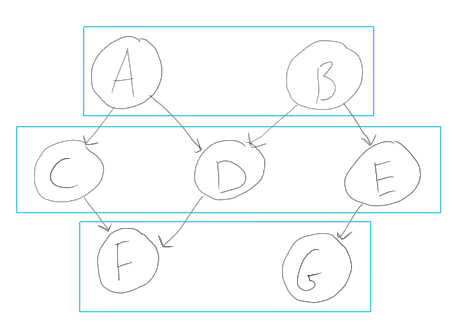Alga is a library for algebraic construction and manipulation of graphs in Haskell. See this Haskell Symposium paper and the corresponding talk for the motivation behind the library, the underlying theory and implementation details. There is also a Haskell eXchange talk, and a tutorial by Alexandre Moine.
Consider the following data type, which is defined in the top-level module Algebra.Graph of the library:
data Graph a = Empty | Vertex a | Overlay (Graph a) (Graph a) | Connect (Graph a) (Graph a)We can give the following semantics to the constructors in terms of the pair (V, E) of graph vertices and edges:
Emptyconstructs the empty graph (∅, ∅).Vertex xconstructs a graph containing a single vertex, i.e. ({x}, ∅).Overlay x yoverlays graphs (Vx, Ex) and (Vy, Ey) constructing (Vx ∪ Vy, Ex ∪ Ey).Connect x yconnects graphs (Vx, Ex) and (Vy, Ey) constructing (Vx ∪ Vy, Ex ∪ Ey ∪ Vx × Vy).
Alternatively, we can give an algebraic semantics to the above graph construction primitives by defining the following type class and specifying a set of laws for its instances (see module Algebra.Graph.Class):
class Graph g where
type Vertex g
empty :: g
vertex :: Vertex g -> g
overlay :: g -> g -> g
connect :: g -> g -> gThe laws of the type class are remarkably similar to those of a semiring,
so we use + and * as convenient shortcuts for overlay and connect, respectively:
- (
+,empty) is an idempotent commutative monoid. - (
*,empty) is a monoid. *distributes over+, that is:x * (y + z) == x * y + x * zand(x + y) * z == x * z + y * z.*can be decomposed:x * y * z == x * y + x * z + y * z.
This algebraic structure corresponds to unlabelled directed graphs: every expression represents a graph, and every graph can be represented by an expression. Other types of graphs (e.g. undirected) can be obtained by modifying the above set of laws. Algebraic graphs provide a convenient, safe and powerful interface for working with graphs in Haskell, and allow the application of equational reasoning for proving the correctness of graph algorithms.
To represent non-empty graphs, we can drop the Empty constructor -- see module
Algebra.Graph.NonEmpty.
To represent edge-labelled graphs, we can switch to the following data type, as explained in my Haskell eXchange 2018 talk:
data Graph e a = Empty
| Vertex a
| Connect e (Graph e a) (Graph e a)Here e is the type of edge labels. If e is a monoid (<+>, zero) then graph overlay can be recovered
as Connect zero, and <+> corresponds to parallel composition of edge labels.
Alga can handle graphs comprising millions of vertices and billions of edges in a matter of seconds, which is fast enough for many applications. We believe there is a lot of potential for improving the performance of the library, and this is one of our top priorities. If you come across a performance issue when using the library, please let us know.
Some preliminary benchmarks can be found here.
The development of the library has been documented in the series of blog posts:
- Introduction: https://blogs.ncl.ac.uk/andreymokhov/an-algebra-of-graphs/
- A few different flavours of the algebra: https://blogs.ncl.ac.uk/andreymokhov/graphs-a-la-carte/
- Graphs in disguise or How to plan you holiday using Haskell: https://blogs.ncl.ac.uk/andreymokhov/graphs-in-disguise/
- Old graphs from new types: https://blogs.ncl.ac.uk/andreymokhov/old-graphs-from-new-types/
Algebraic graphs were implemented in a few other languages, including Agda, F#, Scala and TypeScript.






